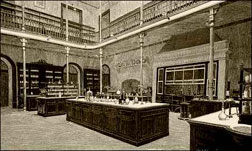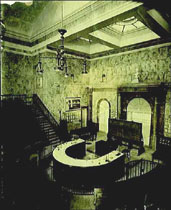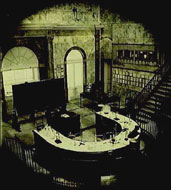|
|
The “Laboratório Chimico” of the Escola Polytechnica
Many of the great science museums throughout the world, such as the Deutsches Museum and the Science Museum in London, are reconstitutions of chemical laboratories of the past, where some classical experiments are reproduced and an explanation is given on how research in this important science began. The Museu de Ciência of the University of Lisbon shows its visitors a live example of an old laboratory, the “Laboratorio Chimico” of the Escola Polytechnica.
The Escola Polytechnica, which in 1911 was transformed into the Faculty of Sciences of the University of Lisbon, was one of the country’s most prestigious teaching institutions. The original building, which contained the Noviciado da Cotovia, was built in 1619 by the Society of Jesus, based on a church built in the same place in 1605. It was located in an exclusive area of the city, the so-called Monte Olivete. In 1755, the building was partially destroyed by the earthquake. A few years later, the Jesuits were expelled from the country and the building was reconstructed, with the intention of housing the recently formed Colégio dos Nobres. In 1766, the new teaching institution was inaugurated. To mark the importance of the occasion, king D. José attended the solemn opening of the academic year.
 |
|
|
|
|
The old laboratory, in a picture of the magazine “O Ocidente” of May 1891. Hofmann recorded “a profusion of space very rarely found” and confesses never having recalled “a laboratory that had been able to combine such elegance and utility so effectively.”
|
|
In 1837, the Colégio dos Nobres was made extinct and the Escola Politécnica was created, later giving its name to the street in front of it. The activity of the new institution was interrupted in 1843 with a fire that almost completely destroyed the old premises. The chemical laboratory was only built in 1857, after the new general reconstruction plan had been approved.
The founders of the laboratory went to great lengths in the design and construction of the laboratory and its equipment, which came to occupy a central place in the new building. The Laboratorio Chimico became the pride of the Portuguese masters and was the admiration of several European chemists. And so began a period in which Portuguese chemistry had considerable international projection.
In the preceding century, Chemistry had become a science in itself. Under the impulse of Antoine Lavoisier (1743-1794), among others, it had adopted a systematic nomenclature and had given a new importance to quantification. In the nineteenth century, Chemistry became specialised in several areas, developing into a collective undertaking. It was at this time that research schools were created in the leading universities and research groups were formed.
The old laboratory, in a picture of the magazine “O Ocidente” of May 1891. Hofmann recorded “a profusion of space very rarely found” and confesses never having recalled “a laboratory that had been able to combine such elegance and utility so effectively.”
Portugal remained abreast of the developments of this science through a few exceptional masters. In the eighteenth century, Vicente Seabra (1764-1804), professor at the University of Coimbra, introduced a new theoretical precision and a new nomenclature in Portugal. One century later, Agostinho Vicente Lourenço (1826-1893), lector responsible for the chemistry experiments of the Escola Politécnica, associated teaching to research and performed pioneering work in preparing polymers, an area which was to gain enormous industrial importance in the twentieth century.
Agostinho Lourenço had worked with Adolphe Wurtz (1817-1884) in the laboratory of the Faculty of Medicine in Paris and had visited several other European laboratories. After fourteen years of research practice abroad, Lourenço returned to Portugal, where he became lector of the Escola Politécnica. His description bears the authority of one who knew the best in Europe: “The chemical laboratory of the school is the vastest and at the same time most grandiose of all the laboratories in Europe in which I have studied or visited; it occupies an area of 860 square metres, including the chemistry amphitheatre, which can accommodate up to 200 students”.
Among Lourenço’s colleagues, one stood out: José Júlio Bettencourt Rodrigues (c. 1845-1893), lector of the subject of Mineral and Inorganic Chemistry. As researcher, Bettencourt Rodrigues collaborated with some of the most prominent scientists of his time. At the Escola Politécnica, he developed industrial applications and perfected photographic and typographic processes. As lector, he introduced compulsory practical and experimental classes where all students were called to the laboratory in order to carry out the experiments themselves. Up until that point, students had practically limited themselves to observing experiments in the amphitheatre, but from now on they were allowed into the laboratory itself where they could handle test tubes and pipits for themselves. Under the direction of Bettencourt Rodrigues, students were required to confirm the results experimentally and were prepared to apply the knowledge acquired to research or industry.
One of the foremost scientists of the time with whom Bettencourt Rodrigues maintained good relations was August von Hofmann (1818-1892), a German chemist who revitalised the teaching and research of science in England and Germany. Hofmann had become famous for developing a process of extracting aniline and for discovering substances based on modern dyeing techniques. On visiting Portugal in 1890, he was impressed with the laboratory of the Politécnica. “I admire most of all the laboratories and the chemistry amphitheatre”, he confessed in a letter addressed to Bettencourt Rodrigues. “Having constructed the laboratories of the universities of Bonn and Berlin”, he added, “I do not hesitate in stating that I know of no other laboratory better prepared for teaching and research”.
More than a century after having served many generations of lecturers and students, the old laboratory has kept its original aspect and still contains many instruments and pieces of furniture that date back to the times of Lourenço and Bettencourt Rodrigues. The fire of 1978 destroyed a large part of the Faculty of Sciences; however, the laboratory was saved and continued to be used by teachers and students alike until 1999. The unfortunate circumstance of not having updated the facilities and equipment in the twentieth century became the fortunate circumstance of having in Portugal today an almost perfect surviving specimen of a period in the past.
|
The entity responsible for the laboratory today is the Museu de Ciência of the University of Lisbon, located in the old Escola Politécnica. In the present day, the laboratory is rather deteriorated by the use of more than one century. One of the priorities of this museum is to recover the Laboratorio Chimico and offer it to the public. The construction project involves the creation of a museum that combines the authenticity of the premises, and of a large part of the equipment, with the didactic aspect that characterises modern interactive museums.
|
 |
|
 |
|
The old amphitheatre, in a photograph taken during its heyday. In the middle is the workbench on which the professors conducted their experiments. Behind the removable board was the rear workbench, which gave direct access to the laboratory, where the assistants and experts prepared the materials which they passed to the professor.
|
|
|
|
|
|
|
|